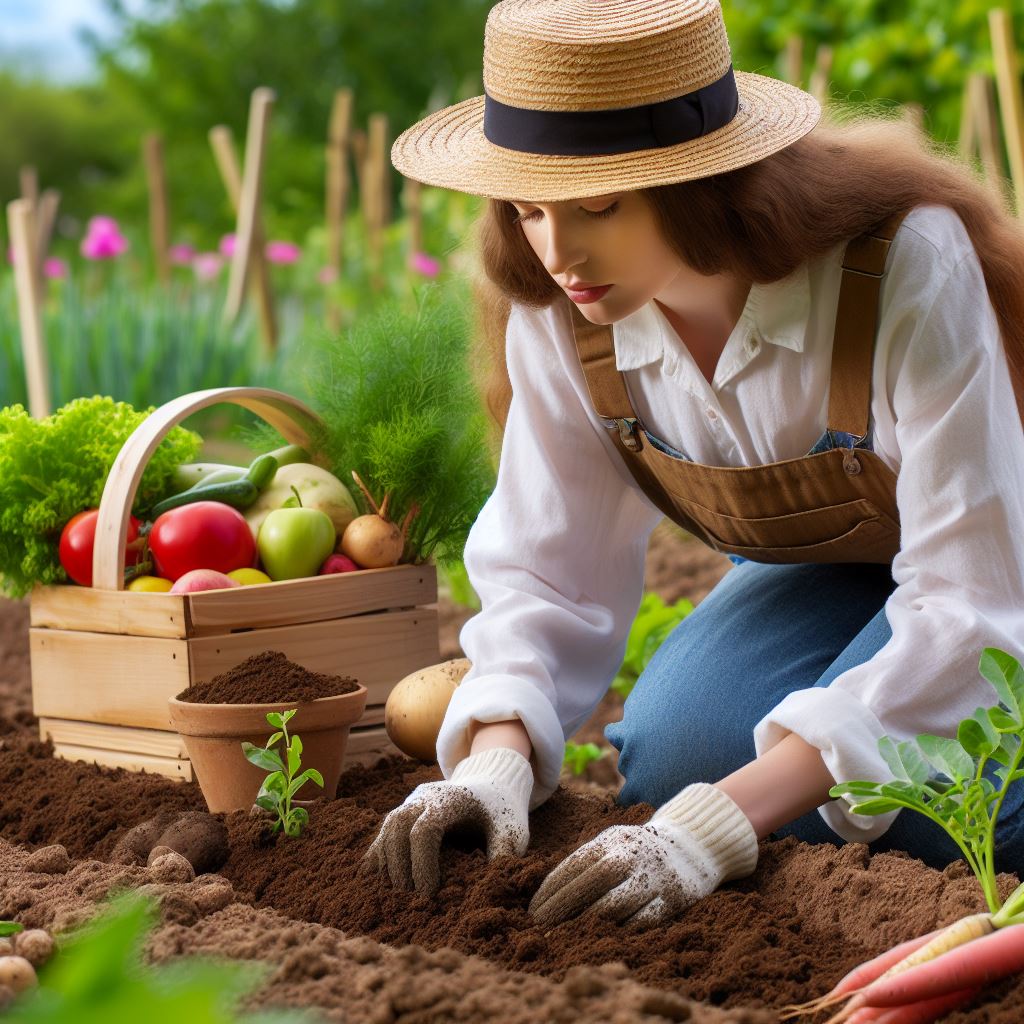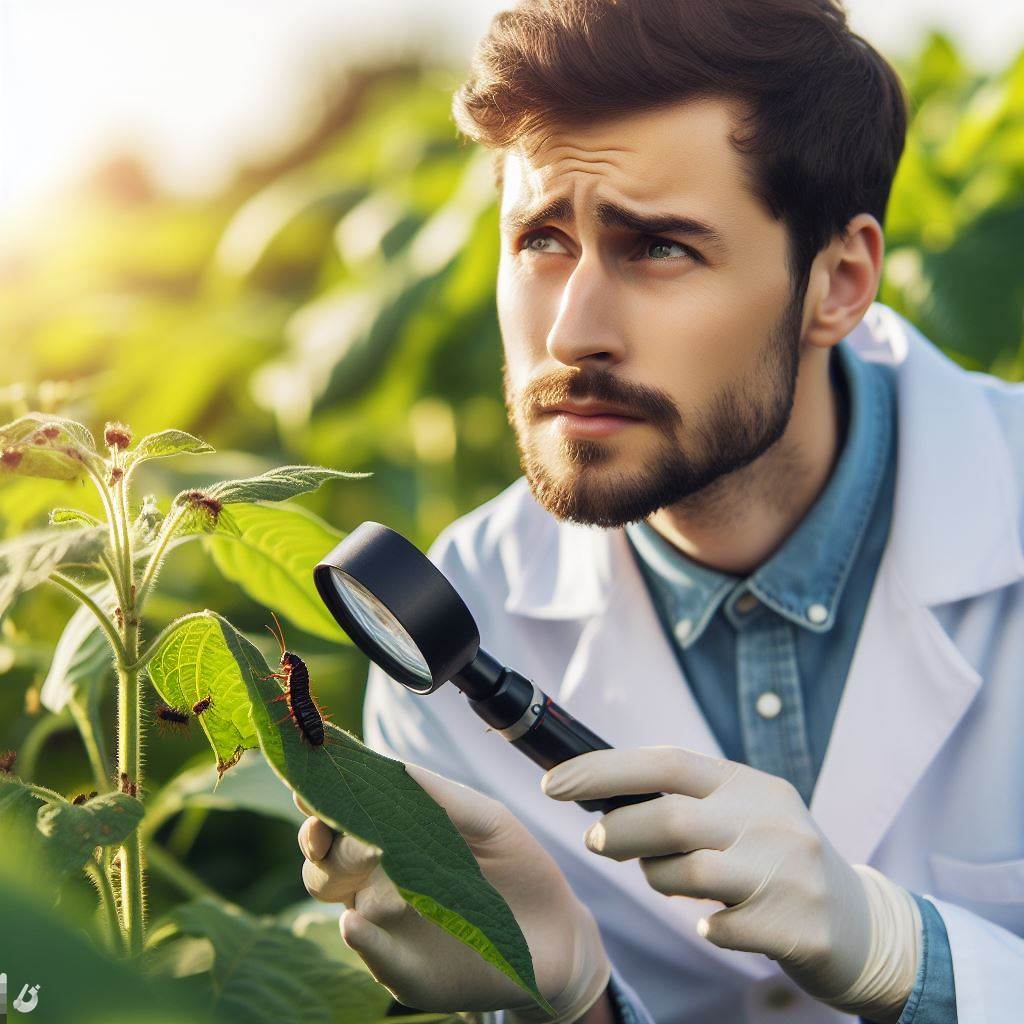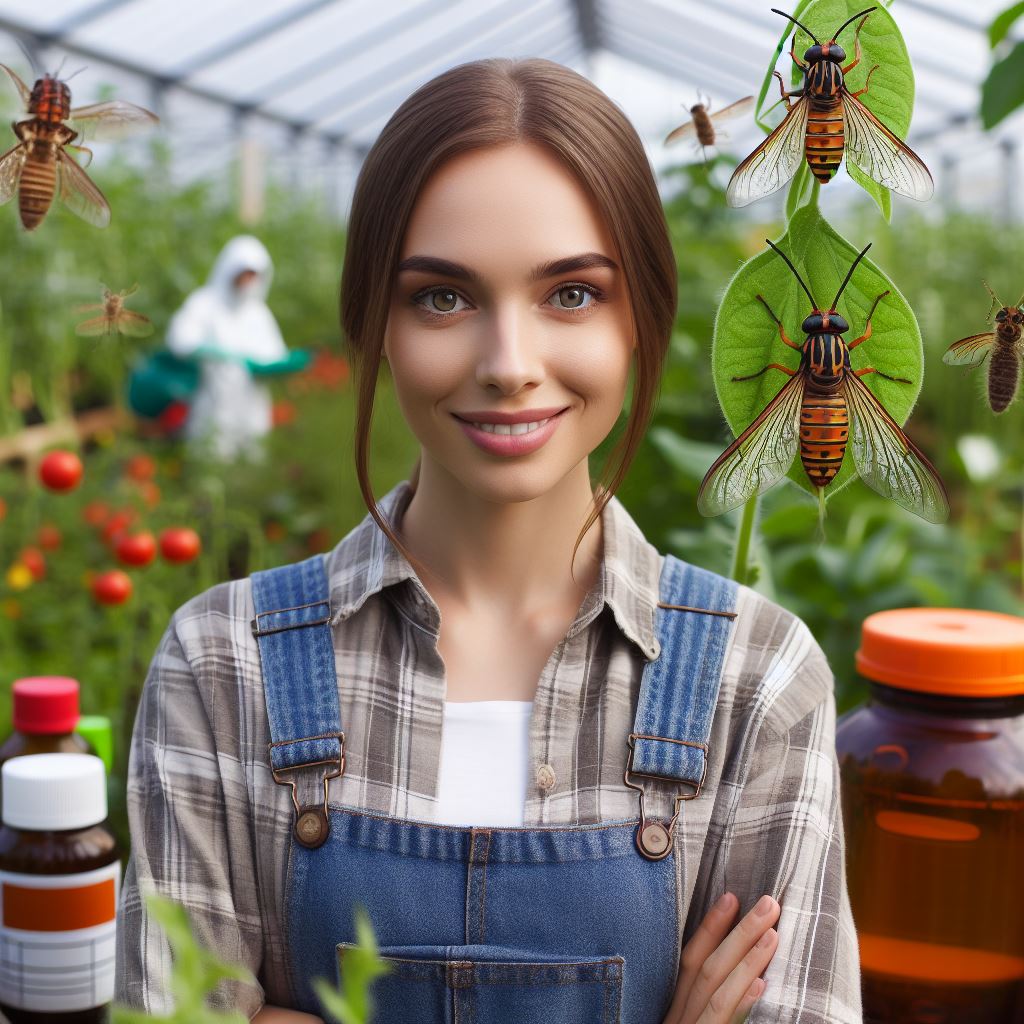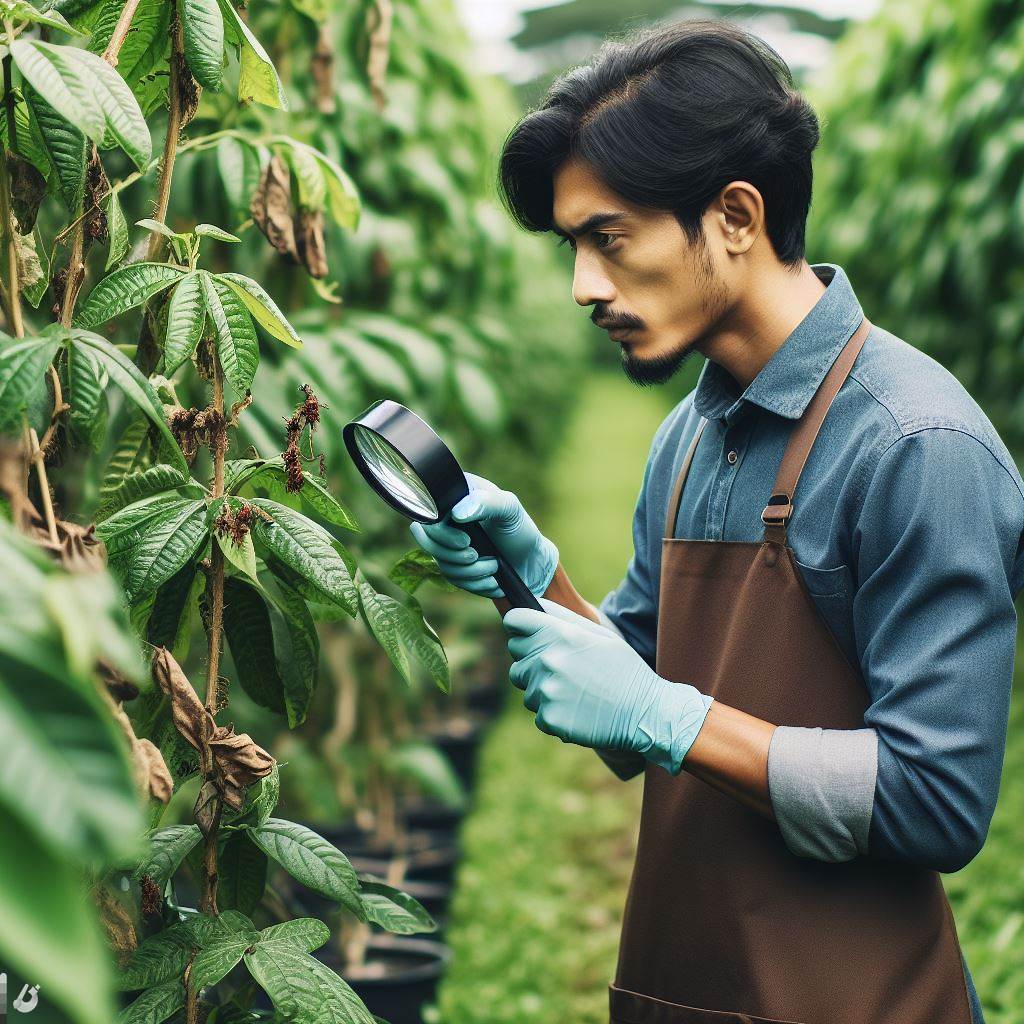Introduction
Integrated Pest Management (IPM) is a comprehensive approach that combines different strategies to effectively manage pests while minimizing harm to the environment and human health.
By integrating various techniques, such as biological control, habitat manipulation, and the use of resistant crop varieties, IPM aims to control pests and diseases in a sustainable manner.
Organic IPM is particularly important for maintaining healthy crops, as it relies on natural and organic solutions instead of synthetic chemicals.
Unlike conventional chemical-based methods, organic IPM focuses on prevention rather than just eradication.
This approach emphasizes the use of cultural practices, crop rotation, and beneficial organisms to prevent pests and diseases from becoming a major problem.
One of the main advantages of organic IPM is its minimal impact on the environment.
By avoiding the use of synthetic pesticides and fertilizers, organic farmers help conserve biodiversity, protect natural habitats, and promote healthy soil ecosystems.
This not only benefits the environment but also ensures the long-term health and productivity of their crops.
Furthermore, organic IPM supports the overall sustainability of farming systems.
By reducing reliance on synthetic chemicals, organic farmers reduce the risk of pesticide resistance and decrease their dependence on nonrenewable resources.
This makes their farming practices more resilient and economically viable in the long run.
In short, the use of organic IPM is crucial for maintaining healthy crops.
By adopting this approach, farmers can effectively manage pests and diseases while minimizing harm to the environment and human health.
Organic IPM not only promotes sustainable farming but also contributes to biodiversity conservation and soil health.
Understanding Organic IPM
Definition and principles of organic IPM
- Organic IPM, which stands for Integrated Pest Management, is an environmentally friendly approach to pest control.
- It focuses on preventing and managing pests through biological, cultural, physical, and chemical controls.
- The goal of organic IPM is to balance pest control with preserving ecosystem health and minimizing harm to beneficial insects.
- It involves monitoring pest populations, identifying the causes of pest outbreaks, and implementing suitable control measures.
- Organic IPM also emphasizes the use of non-toxic or least toxic pest control methods as a first line of defense.
Advantages of using organic IPM over conventional methods
- Reduced reliance on chemical pesticides: Organic IPM minimizes the use of hazardous chemical pesticides and promotes alternative strategies.
- Environmental protection: By avoiding or reducing the use of synthetic pesticides, organic IPM helps protect water, soil, and air quality.
- Preservation of natural enemies: This approach encourages the presence of beneficial insects that prey on pests, maintaining ecological balance.
- Improved crop quality and nutrition: Organic IPM helps produce healthier crops that are free from chemical residues.
- Enhanced resistance management: Organic IPM takes a proactive approach to manage pests, reducing the risk of resistance development.
- Safer working conditions: Farmers and workers in organic IPM systems are exposed to fewer harmful chemicals.
- Cost-effective: Although initial implementation of organic IPM may require more labor, it can save costs in the long run by reducing pesticide use.
Implementing Organic IPM
Steps to implement organic IPM
- Identify and monitor pests: Regularly inspect crops for signs of pest damage and identify the specific pests present.
- Set action thresholds: Determine the pest population level at which action should be taken to prevent significant damage.
- Establish preventive measures: Implement cultural practices such as crop rotation, habitat manipulation, and sanitation to reduce pest pressure.
- Utilize biological controls: Introduce beneficial organisms like predators, parasites, and pathogens to suppress pest populations.
- Implement physical controls: Use physical barriers, traps, and exclusion methods to prevent pests from reaching crops.
- Consider least-toxic pesticides: If necessary, choose organic-approved pesticides that have low environmental impact and pose minimal risks.
- Evaluate and adjust: Regularly assess the effectiveness of implemented measures and modify strategies as needed.
Beneficial insects in organic IPM
- Ladybugs: Ladybugs and their larvae feed on aphids, mites, and other soft-bodied pests.
- Lacewings: Lacewing larvae prey on aphids, thrips, mealybugs, and caterpillar eggs.
- Parasitic wasps: These wasps lay their eggs inside pest insects, gradually killing them.
- Predatory mites: These mites feed on spider mites and other small pests, helping control their populations.
- Hoverflies: Hoverfly larvae eat aphids and other small insects, reducing pest numbers.
In fact, organic IPM is a holistic approach to pest management that prioritizes the health of crops and the environment.
Transform Your Agribusiness
Unlock your farm's potential with expert advice tailored to your needs. Get actionable steps that drive real results.
Get StartedBy understanding its definition, principles, and advantages over conventional methods, farmers can make more informed decisions to implement organic IPM practices.
Utilizing the steps and taking advantage of beneficial insects can effectively control pests while reducing reliance on harmful pesticides.
Organic IPM not only promotes sustainable agriculture but also contributes to healthier crops and ecosystems in the long run.
Read: IPM: Balancing Nature & Agriculture Sustainably
Identification and Monitoring of Pest Problems
Conducting regular crop inspections
Regular crop inspections are essential in identifying and preventing pest problems.
By closely observing the plants, farmers can detect any signs of pests or diseases early on.
During the inspections, all parts of the crop should be thoroughly examined, including leaves, stems, fruits, and roots.
Look for visible symptoms such as leaf spots, wilting, discoloration, or any unusual growth patterns.
It is also crucial to note any environmental conditions that may contribute to pest issues, such as excessive moisture, lack of sunlight, or poor soil quality.
These factors can make the crops more susceptible to infestations.
By conducting regular inspections, farmers can take immediate action when pest problems are detected, preventing further damage to the crops.
Identifying common pests and diseases
Accurate identification of pests and diseases is crucial in implementing effective organic IPM solutions.
Familiarize yourself with the common pests and diseases that affect your crops.
There are various resources available, such as field guides, online databases, and local agricultural extension services, that can help farmers identify specific pests and diseases.
Transform Your Agribusiness Online Presence
Stand out with compelling content tailored to engage your audience and drive results. From blog posts to social media, we’ll create what your business needs to grow.
Get StartedFor accurate identification, pay attention to the physical characteristics of the pests, like size, color, shape, and feeding patterns. Identify the diseases based on symptoms such as leaf spots, fungal growth, or wilting.
Knowing the specific pests and diseases enables farmers to choose the most appropriate control methods and develop targeted IPM strategies.
Monitoring pest populations and damage levels
Regular monitoring of pest populations and damage levels allows farmers to assess the severity of infestations and make informed decisions regarding pest control measures.
Various monitoring techniques can be employed, such as visual inspections, trapping, or the use of pheromone traps to attract and capture specific pests.
Record and track the number of pests captured, pest life cycle stages, and damage levels over time. This information is valuable in determining the appropriate intervention measures.
Monitoring should be done consistently throughout the growing season to detect changes in pest populations and adjust management techniques accordingly.
In essence, identification and monitoring are essential components of an effective organic IPM program.
By conducting regular crop inspections, farmers can detect and prevent pest problems early on.
Accurate identification of common pests and diseases is crucial in implementing targeted IPM strategies.
Monitoring pest populations and damage levels helps farmers assess the severity of infestations and make informed decisions regarding pest control measures.
By integrating these practices into their farming techniques, growers can promote healthy crops and reduce the reliance on chemical pesticides.
Read: Eco-Friendly IPM Techniques in Modern Farms
Prevention and Cultural Practices
In order to promote healthy crops and prevent the onset of pests and diseases, it is important to implement effective prevention and cultural practices.
By adopting these techniques, farmers can minimize the reliance on chemical interventions and create a sustainable agricultural system.
Unlock Farming Insights for Growth
Make smarter farming decisions with detailed reports on market trends, weather patterns, and soil health tailored to your farm's success. Boost productivity with actionable data.
Get ReportCrop Rotation and Diversification
Crop rotation involves systematically changing the type of crops grown in a particular field over time.
This practice helps disrupt the life cycles of pests and pathogens, reducing their populations and limiting their impact on crops.
Diversification, on the other hand, refers to the planting of different crop species within the same field or farm.
This helps create natural barriers against pests and diseases.
- Regularly rotating crops and introducing diversity in the planting system can improve soil health and reduce pest pressure.
- It disrupts the life cycles of pests, preventing the buildup of specific pest populations.
- Different crops have different nutrient needs, which can help prevent soil depletion.
- Diversification creates a less favorable environment for pests since they have limited food sources.
Maintaining Healthy Soil
Healthy soil is the foundation for healthy crops. Implementing practices that enhance soil health can improve plant resilience and reduce the occurrence of pests and diseases.
- Regular soil testing and analysis can help identify nutrient deficiencies and imbalances.
- Adding organic matter, such as compost or cover crops, can improve soil structure and nutrient content.
- Reducing soil erosion through practices like conservation tillage helps retain essential nutrients.
- Encouraging beneficial soil organisms, like earthworms, increases nutrient cycling and improves soil fertility.
Proper Irrigation and Drainage Techniques
Water management plays a crucial role in preventing the onset of various crop diseases and pests.
Inappropriate irrigation and drainage techniques can create a favorable environment for their growth and spread.
- Watering plants at the right time and avoiding water stress helps plants maintain their vigor and resist diseases.
- Implementing proper drainage systems prevents waterlogged conditions that promote fungal diseases.
- Using drip irrigation or other targeted watering methods minimizes moisture on foliage, reducing the chance of foliar diseases.
- Regularly monitoring soil moisture levels helps avoid overwatering or underwatering, both of which can weaken plants.
In general, prevention and cultural practices are essential components of organic IPM solutions for healthy crops.
Crop rotation and diversification, along with maintaining healthy soil and implementing proper irrigation and drainage techniques, create a sustainable farming system that minimizes the reliance on synthetic pesticides and promotes overall crop health.
Read: Permaculture Principles: Soil Health Focus
Biological Control Methods
In this section, we will discuss the various biological control methods that can be used to promote healthy crops in organic IPM solutions.
Introduction to Beneficial Insects
Beneficial insects play a crucial role in organic Integrated Pest Management (IPM) by preying on pests.
They are a natural alternative to chemical pesticides and can help maintain a healthy ecosystem.
Some common beneficial insects include ladybugs, lacewings, parasitic wasps, and predatory mites.
These insects can control pests by feeding on them, laying their eggs on pest eggs, or parasitizing pests.
Attracting and Releasing Beneficial Insects
One way to encourage beneficial insects in your crop fields is by creating habitats that attract them.
This can be done by incorporating diverse plant species that provide nectar, pollen, and shelter.
Planting flowering plants such as daisies, marigolds, and sunflowers can attract beneficial insects.
Additionally, providing water sources like small ponds or shallow dishes can attract certain beneficial insects.
Releasing commercially reared beneficial insects can also be beneficial in pest control.
Before releasing, it’s important to understand the optimal conditions for the specific insect species.
Releasing insects during early morning or late afternoon when temperatures are cooler is often recommended.
Using Insectary Plants to Enhance Biological Control
Insectary plants are specific plant species that provide resources for beneficial insects.
These plants can be intercropped with cash crops or strategically placed throughout the field.
They offer nectar, pollen, and alternative prey, which can help sustain beneficial insect populations.
Insectary plants like clover, buckwheat, and fennel attract predatory insects and parasitoid wasps.
They can also serve as a breeding habitat for beneficial insects.
By establishing and maintaining insectary plants, farmers can enhance biological control in their fields.
In brief, biological control methods, such as attracting beneficial insects and using insectary plants, are essential in promoting healthy crops in organic IPM solutions.
By harnessing the power of nature, farmers can reduce reliance on chemical pesticides and create a sustainable agricultural ecosystem.
Implementing these methods requires careful planning and knowledge of specific beneficial insect species and their requirements.
However, the rewards of a balanced pest management system and healthier crops are well worth the effort.
With further research and understanding, organic farmers can continue to refine and optimize these methods to achieve even greater success in crop health and productivity.
Read: Cover Crop Mixes: Soil Health Multipliers

Physical and Mechanical Control Measures
Barriers and Exclusion Techniques
Barriers and exclusion techniques are vital components of organic integrated pest management (IPM) solutions.
By physically preventing pests from accessing crops, these measures can effectively reduce pest populations without the need for chemical pesticides.
- Fencing: Installing fences around fields or gardens can serve as a physical barrier, preventing larger pests such as deer or rabbits from reaching crops.
- Netting: Fine mesh or netting can be used to cover plants and create a barrier that keeps out flying insects like aphids or caterpillars.
- Row Covers: These covers are placed directly over rows of crops, offering protection from pests while still allowing sunlight, water, and air to reach the plants.
Traps and Pheromone Lures
Traps and pheromone lures are effective physical control measures that rely on attracting and capturing pests. These methods help to disrupt pest breeding cycles and prevent damage to crops.
- Sticky Traps: These traps are coated with a sticky substance that insects get stuck to when they come into contact, preventing them from reaching crops.
- Pheromone Traps: Pheromones are natural scents released by insects to attract mates. Pheromone traps mimic these scents to lure pests into traps, preventing them from reproducing.
- Light Traps: These traps attract insects to a light source and then capture them. They are particularly effective for controlling flying pests like moths or beetles.
Mulching and Weed Management
Mulching and weed management are essential measures that physically control pests by creating unfavorable conditions for their growth and survival.
- Mulching: Applying organic mulch, such as straw or compost, around plants serves as a physical barrier that deters pests from reaching the soil and laying eggs.
- Weed Control: Removing weeds from the vicinity of crops helps prevent them from serving as host plants for pests or competing with crops for resources.
- Cultural Practices: Implementing proper crop rotation, intercropping, and maintaining healthy soil conditions can also reduce pest populations and improve overall crop health.
In review, physical and mechanical control measures play a crucial role in organic IPM solutions.
By utilizing barriers, traps, mulching, and weed management, farmers can effectively control pests without resorting to harmful chemical pesticides.
These methods not only protect crops but also promote a healthy and sustainable agricultural system.
Organic Pesticides and Solutions
Safer and approved organic pesticide options
- Neem oil, derived from the neem tree, is an effective organic pesticide for controlling aphids, spider mites, and other pests.
- Bacillus thuringiensis (Bt) is a natural bacteria that kills caterpillars and other harmful insects without harming beneficial insects.
- Pyrethrin, derived from chrysanthemum flowers, is a widely used organic pesticide that effectively controls a wide range of pests.
- Diatomaceous earth, made from the fossilized remains of diatoms, is a physical pesticide that kills pests by piercing their exoskeletons.
- Horticultural oils, such as mineral oil or vegetable oil, suffocate and kill a wide range of pests.
Homemade pesticide recipes using natural ingredients
- Garlic and pepper spray: Mix crushed garlic cloves and cayenne pepper with water to create a potent spray that repels many pests.
- Soap spray: Dissolve a mild liquid soap in water and spray it on plants to control aphids, whiteflies, and other soft-bodied insects.
- Oil spray: Combine vegetable oil and mild soap in water to create an effective pesticide that suffocates and kills pests.
- Citrus oil spray: Extract the oil from citrus fruits like oranges or lemons and mix it with water to create a natural pesticide.
- Coffee grounds: Sprinkling used coffee grounds around plants can repel pests like slugs and snails.
Correct application and timing of organic pesticides
- Follow the manufacturer’s instructions for diluting and applying organic pesticides to ensure their effectiveness.
- Apply organic pesticides early in the morning or late in the evening when beneficial insects are less active.
- Use targeted application methods like spot treatments or applying pesticides only to affected plants to minimize harm to beneficial insects.
- Monitor pest populations regularly to determine the appropriate timing for pesticide applications.
- Avoid excessive pesticide use to maintain a balanced ecosystem and prevent the development of resistant pest populations.
In a nutshell, organic pesticides offer safer and approved options for controlling pests in crop production.
With options like neem oil, Bt, pyrethrin, diatomaceous earth, and horticultural oils, farmers can effectively manage harmful insects without harming beneficial ones.
Additionally, homemade pesticide recipes using natural ingredients provide a cost-effective alternative.
However, it is crucial to correctly apply these pesticides and consider the timing to minimize harm to beneficial insects.
By following these practices, farmers can achieve healthy crops while maintaining an environmentally friendly approach.
Integrated Approach for Effective Organic IPM
Achieving healthy and pest-free crops in organic farming requires a comprehensive and integrated approach.
Integrated Pest Management (IPM) is a strategy that combines various control measures, customized plans, and continuous monitoring and adjustment of strategies based on results.
Combining Various Control Measures
One of the key principles of organic IPM is to utilize multiple control measures to manage pests effectively.
This approach aims to maximize pest control while minimizing the use of synthetic pesticides.
One control measure is biological control, which involves using natural enemies such as beneficial insects, predatory mites, or nematodes to control pests.
These organisms prey on or parasitize pests, reducing their population and impact on crops.
Cultural control is another effective method that involves manipulating the crop’s environment to discourage pest development.
For example, rotating crops, practicing proper sanitation, and maintaining proper plant spacing can help prevent the buildup of pest populations.
Mechanical and physical controls are also crucial components of IPM.
These include physical barriers, like nets or screens, to prevent pests from accessing plants.
Additionally, mechanical controls can involve handpicking or using traps to physically remove pests from crops.
Furthermore, the use of botanical pesticides derived from plant extracts can provide an additional tool in controlling pests organically.
These natural compounds have insecticidal properties and can be an effective alternative to synthetic chemical pesticides.
Developing Customized IPM Plans for Different Crops
Each crop has unique pest challenges, making it important to develop customized IPM plans.
A tailored approach helps identify specific pests and their life cycles, ensuring appropriate control measures are implemented.
A comprehensive IPM plan involves understanding the key pests for each crop, their life stages, and the timing of their infestations.
This knowledge serves as the foundation for selecting appropriate control measures and implementing them at the right times.
It is also important to consider the crop’s growth stage when developing an IPM plan. Different control measures may be more effective at specific stages of crop development.
For example, applying biological control agents during early stages may provide better pest control.
Additionally, farmers need to consider the ecological factors of their farms, such as neighboring crops, soil type, and weather patterns, when creating customized IPM plans.
These factors influence pest pressure and the effectiveness of different control methods.
Monitoring and Adjusting IPM Strategies Based on Results
A successful organic IPM program requires regular monitoring of pest populations and crop health.
Monitoring allows farmers to assess the effectiveness of their control measures and make necessary adjustments.
Various monitoring methods can be employed, including visual inspections, pheromone traps, sticky traps, and trap crops.
By monitoring pest populations and damage levels, farmers can determine if further actions are needed to maintain crop health.
Based on monitoring results, adjustments can be made to the IPM strategies.
This may involve increasing or decreasing the use of specific control measures, modifying the timing of treatments, or trying new methods based on emerging research and technologies.
Continuous learning and adaptation are crucial for effective organic IPM.
Through ongoing monitoring and adjustment, farmers can optimize pest management, improve crop health, and reduce reliance on synthetic pesticides.
In summary, an integrated approach is essential for effective organic IPM.
Combining various control measures, developing customized IPM plans, and continuously monitoring and adjusting strategies based on results ensure healthy and pest-free crops while preserving the integrity of organic farming.
Conclusion
Throughout this blog, we have emphasized the significance of organic Integrated Pest Management (IPM) for healthier crops.
By utilizing organic IPM practices, farmers can effectively manage pests while minimizing harmful impact on the environment.
We strongly encourage farmers to embrace organic IPM as a sustainable approach to crop protection.
By adopting these practices, they can reduce reliance on synthetic pesticides, protect the ecosystem, and promote biodiversity.
The future of organic IPM holds great potential. Ongoing research is focused on developing new organic pest control methodologies, improving pest surveillance techniques, and enhancing biocontrol agents’ efficiency.
Organic IPM is a vital aspect of modern agriculture. It offers a sustainable and environmentally-friendly approach to crop protection while ensuring healthy and productive yields.
By adopting organic IPM practices, farmers can contribute to a greener and safer agricultural future.




